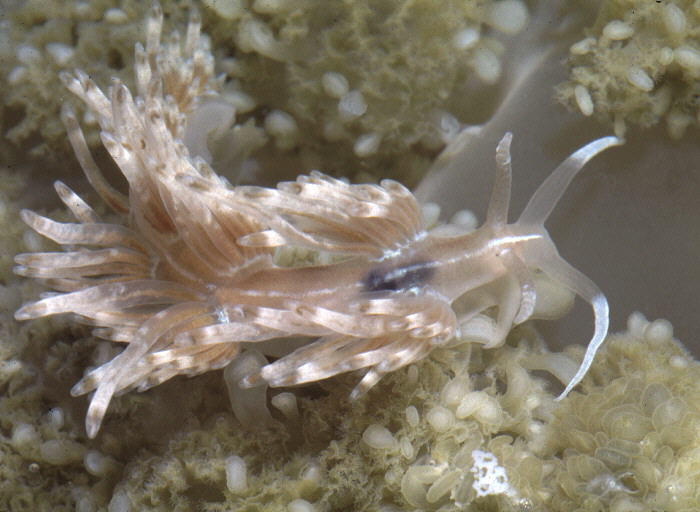 |
Dondice parguerensis
Photo courtesy of Jeff Hamann of El Cajon, California.
Lark Caye, Belize
Central America
Dondice parguerensis Brandon & Cutress, 1985
Dondice parguerensis is one of the most fascinating aeolid nudibranchs found in the Caribbean. Originally described from La Parguera, Puerto Rico (the trivial name meaning "from Parguera"), this species of Dondice lives its entire life cycle in association with the scyphozoan medusa Cassiopea frondosa, otherwise known as the upside down jellyfish. The specimens shown here were photographed by Jeff Hamann, of El Cajon, California, while on our March 1992 collecting trip to the Honduran barrier reef off the coast of Belize, Central America. Jeff and I found these specimens while exploring a quiet, extremely warm, mangrove area on Lark Caye.
Large (20-25 cm in diameter) specimens of Cassiopea were found pulsating upside down on the silty bottom in sunlit area of the mangrove swamp. Several specimens of Dondice measured up to almost 34 mm in length. The specimens were found with their long string-like egg masses hanging in the oral tentacles of the jellyfish.
In the original description by Marielle Brandon and Charles Cutress, it was noted that in Puerto Rico, this species was most abundant during September to February, but can be found year round in quiet waters to 8 m deep. The aeolid is also found on the other upside down species, Cassiopea xamachana.
This nudibranch/coelenterate association should be considered "parasitic" as the Branch is deriving all the benefit, food, protection and substrate; the poor jellyfish, gets nothing out of the deal. The eggs are even laid directly on the jelly and the planktotrophic larvae are thought to settle directly upon the medusa.
This species differs from the other Caribbean species, Dondice occidentalis (to be featured as a Nudibranch of the Month, separately), in three noticeable characteristics. D. parguerensis is larger, reaching 48 mm (D. occidentalis is rarely over 30 mm). It has nine groups of cerata (D. occidentalis has six) and it lacks the red medial stripe that runs along the head and body to the tail (D. parguerensis closely mimics the color of the jellyfish).
Although quite cryptically colored, Dondice parguerensis is relatively easy
to find and photograph because of exclusive occurrence of its specific food
preference. The next time you see Cassiopea pulsating rhythmically on the
bottom, pick it up and take a close look at the oral arms , or
tentacles of the jellyfish.
Presence of the thin cream colored egg thread is a sure give away that
somewhere is that bouquet of tentacles an adult nudibranch is to be found.
This is one of Mother Nature's truly interesting associations.
Taxonomic information courtesy of Dave Behrens

David W. Behrens |
Dave and Diana, of Sea Challengers Natural History Books, would like to wish
all their Slug Site viewing buddies a warm and wonderful Holiday Season. They
invite you to visit their on-line bookstore where they are offering a Christmas
Special on four of the most beautiful underwater art books available today.
This is a great opportunity to grab that last minute gift for your dive partner
or slug buddy.
Holiday Specials - 10% off Regular Prices - Order 2 or more of these
books - 20% off Regular prices: |
Author:
Pacific Coast Nudibranchs
Co-Author Coral Reef Animals of the Indo Pacific
Propriator of Sea Challengers Natural History Books !
Send Dave mail at seachalleng@earthlink.net
